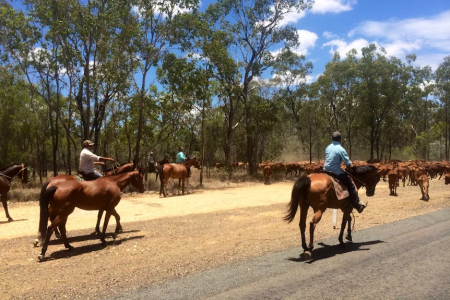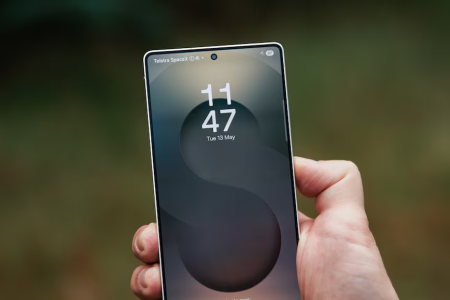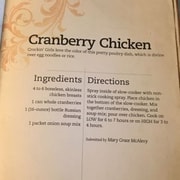Telstra launches Australia's first direct-to-satellite text messaging service
By
ABC News
- Replies 3
There is hope an Australia-first service using satellites to deliver text messages anywhere in the country will grow to become a game changer for Australians in mobile black spots.
Telstra has launched a mobile-to-satellite service for some customers, delivered through SpaceX's Starlink service.
While currently only available on select new phones, the technology is considered a significant breakthrough, providing coverage for people outside land-based 4G and 5G networks.
Communications analyst Graham Lynch said while it was still early days, the technology had massive implications for rural Australians.
Initially, customers will only be able to text message using the service, and it will only work on a Samsung Galaxy S25 handset.
Telstra's executive for technology engagement, Channa Seneviratne, said it was working to add additional handsets.
"In time, there will be more, including future support for Apple devices," Mr Seneviratne said.
He said the service would be part of the standard contract, so there would be no extra charges, but he warned there could be some delays in sending and receiving messages.
"If the satellite is not quite overhead, it could take a few minutes," he said.
Reliability questions
Accompanying the rollout of the new service are questions about its reliability.
Mr Lynch said testing of similar services in the United States produced patchy results.
"Messages get dropped, messages get missed," he said.
He said getting a reliable connection was challenging because low-Earth-orbit satellites (LEOsats) themselves are moving at about 25,000 kilometres per hour.
"The LEOsats are spinning very fast around a planet that is itself spinning very fast, so there's a lot of calibration involved in the physics," he said.
How does it work?
The new messaging service uses LEOsats and direct-to-device (D2D) technology to transmit signals from space directly to mobile phones.
Users will connect automatically to the Starlink satellite if they are beyond the range of Telstra's mobile network on mainland Australia and Tasmania, excluding the Australian Radio Quiet Zone in Western Australia and remote offshore territories and islands.
Many rural Australians are already using LEOsats to connect to services like Starlink, Sky Muster, Intelsat and Inmarsat for internet browsing, email, voice calls and texting.
But the CEO of the Association of Mining and Exploration Companies, Warren Pearce, said the technology had potentially life-saving implications for prospectors and others working remotely.

What's next?
Telstra said the service did not connect to emergency services yet and users would have to text a third party to call triple-0.
TPG-Vodafone has already tested a service and Optus is working on it as well.
Telstra is working on enabling voice calls using the LEOsat network, but it will not be available until 2027.
Mr Pearce said that would be significant.
"If we can get to a point where we can make contact and have a conversation in every part of Australia, I think that would be a major breakthrough," he said.
Labor promised to include LEOsat services in the federal government's universal mobile service obligation (UMSO) by 2027 if it was elected at the most recent poll.
This would require telcos to offer satellite services alongside mobile and fixed services.
If that happens, Australia will be the first country in the world to take that step.
Mr Lynch said other countries like the US and New Zealand were offering the service, but reliability was still an issue.
"They're not at the level where they can provide guarantees, which is what makes what Australia is planning to do so novel," he said.
Written by David Claughton, ABC News.
Telstra has launched a mobile-to-satellite service for some customers, delivered through SpaceX's Starlink service.
While currently only available on select new phones, the technology is considered a significant breakthrough, providing coverage for people outside land-based 4G and 5G networks.
Communications analyst Graham Lynch said while it was still early days, the technology had massive implications for rural Australians.
Initially, customers will only be able to text message using the service, and it will only work on a Samsung Galaxy S25 handset.
Telstra's executive for technology engagement, Channa Seneviratne, said it was working to add additional handsets.
"In time, there will be more, including future support for Apple devices," Mr Seneviratne said.
He said the service would be part of the standard contract, so there would be no extra charges, but he warned there could be some delays in sending and receiving messages.
"If the satellite is not quite overhead, it could take a few minutes," he said.
Reliability questions
Accompanying the rollout of the new service are questions about its reliability.
Mr Lynch said testing of similar services in the United States produced patchy results.
"Messages get dropped, messages get missed," he said.
He said getting a reliable connection was challenging because low-Earth-orbit satellites (LEOsats) themselves are moving at about 25,000 kilometres per hour.
"The LEOsats are spinning very fast around a planet that is itself spinning very fast, so there's a lot of calibration involved in the physics," he said.
How does it work?
The new messaging service uses LEOsats and direct-to-device (D2D) technology to transmit signals from space directly to mobile phones.
Users will connect automatically to the Starlink satellite if they are beyond the range of Telstra's mobile network on mainland Australia and Tasmania, excluding the Australian Radio Quiet Zone in Western Australia and remote offshore territories and islands.
Many rural Australians are already using LEOsats to connect to services like Starlink, Sky Muster, Intelsat and Inmarsat for internet browsing, email, voice calls and texting.
But the CEO of the Association of Mining and Exploration Companies, Warren Pearce, said the technology had potentially life-saving implications for prospectors and others working remotely.

People living and working remotely will be able to send a text message via their smart phone for the first time. (ABC News: Zara Margolis)
What's next?
Telstra said the service did not connect to emergency services yet and users would have to text a third party to call triple-0.
TPG-Vodafone has already tested a service and Optus is working on it as well.
Telstra is working on enabling voice calls using the LEOsat network, but it will not be available until 2027.
Mr Pearce said that would be significant.
"If we can get to a point where we can make contact and have a conversation in every part of Australia, I think that would be a major breakthrough," he said.
Labor promised to include LEOsat services in the federal government's universal mobile service obligation (UMSO) by 2027 if it was elected at the most recent poll.
This would require telcos to offer satellite services alongside mobile and fixed services.
If that happens, Australia will be the first country in the world to take that step.
Mr Lynch said other countries like the US and New Zealand were offering the service, but reliability was still an issue.
"They're not at the level where they can provide guarantees, which is what makes what Australia is planning to do so novel," he said.
Written by David Claughton, ABC News.









